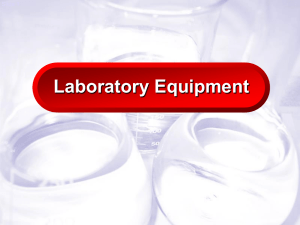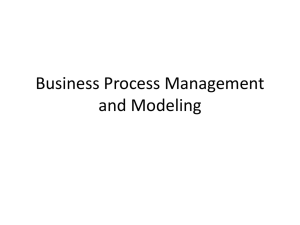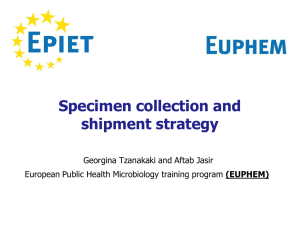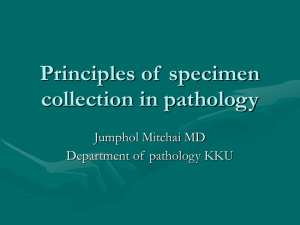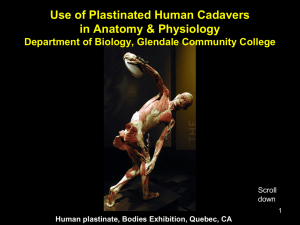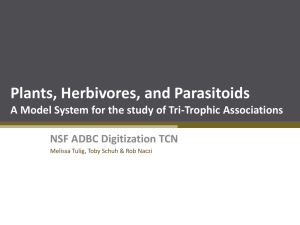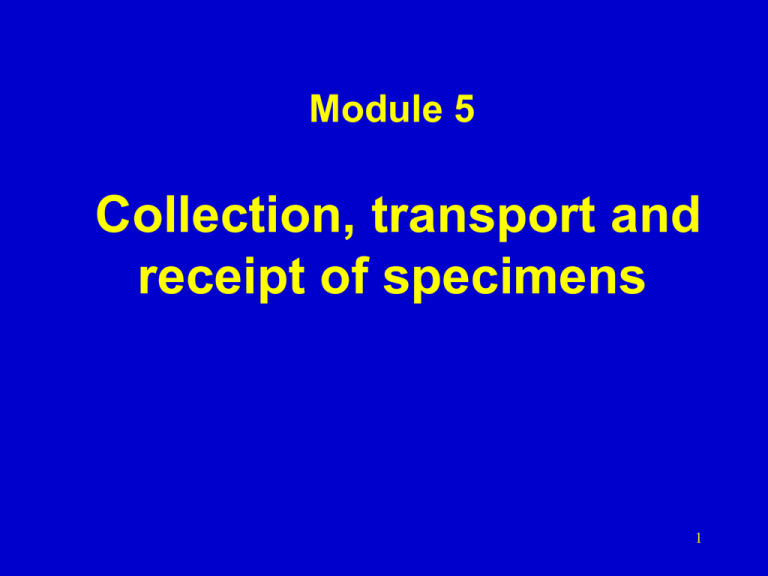
Module 5
Collection, transport and
receipt of specimens
1
Learning objectives
At the end of this module you will be able to:
explain the proper collection of specimens;
explain how to select suitable containers for the collection
of different specimens;
explain the proper labelling of specimens to be submitted
to the TB laboratory;
explain the proper transportation of specimens;
list the features of a good specimen;
fill in the laboratory register.
2
Content outline
•
•
•
•
•
•
Procedure for specimen collection
Suitable specimen containers
Transport of specimens
Receipt of incoming specimens
Evaluation of specimen quality
Specimens and request forms: quality assurance
3
REMEMBER!
Unless specimens are collected with the utmost care and
promptly transported to the laboratory under the proper
conditions, the advantages of culture will not be fully
realized.
If sputa are stored at 4°C, delay between collection and
inoculation should not exceed 7 days.
4
Collection procedures for
sputum specimens
SPOT
MORNING
SPOT
New WHO policy:
•two samples (better if one is
a morning sample).
Can be adopted where good
quality assurance
programmes are in place
(good performance
documented) in countries
with high workloads and
limited human resources.
Minimum volume: 2 ml (optimal volume: 5 ml)
5
Collection procedures for
other specimens
• Specimens from sterile sites, aseptically
collected.
• Specimens from non-sterile sites,
specimens expected to be
contaminated by normal flora, or
specimens not collected under sterile
conditions.
6
Other respiratory specimens
• Bronchial aspirate (2–5 ml).
• Bronchial alveolar lavage (20–40 ml).
• Transbronchial biopsies, brushing (add 0.5–1 ml
sterile saline to avoid drying).
• Pleural effusion (20–50 ml).
• Pleural biopsy
• Gastric aspirate (early morning, empty stomach,
transport immediately to the laboratory, neutralize by
adding 1–2 ml of 10% trisodium phosphate solution,
depending on the specimen volume or 100mg of
sodium bicarbonate): for children, or people unable
to produce sputum .
7
Contaminated specimens:
instructions for urine collection
• External genitalia should be
washed before specimen
collection.
• A single early-morning urine
specimen (approx. 200 ml)
should be collected.
• Specimens should be
refrigerated or transported
immediatelyto the laboratory.
8
Aseptically collected fluids
Body fluids:
– spinal
– pleural
– pericardial
– synovial
– ascitic
– blood (5–10 ml citrate blood)
– sperm and prostate secretion (no addition)
– pus
– bone marrow.
9
Aseptically collected fluids:
additives?
• Sterile containers without fixatives or
preservatives must be used.
• If clots are expected, add an anticoagulant,
e.g. potassium oxalate (0.01–0.02 ml of 10%
neutral oxalate per ml fluid), or heparin
(0.2 mg/ml), or sodium citrate (two drops of
20% sodium citrate for every 10 ml of fluid).
10
Aseptically collected tissues
• Keep at 4–15 °C.
• Avoid drying.
• Deliver specimens to the laboratory as
quickly as possible.
11
Proper containers for sputa
•
•
•
•
•
•
Robust
Leakproof
Clean
50-ml capacity
Translucent or clear material
Single-use combustible
material
• Wide-mouthed, screwcapped with a watertight seal
• Easily-labelled walls
12
Preservation methods for
sputum samples (1)
• Sputum samples should be delivered to the
laboratory without any delay.
• When samples cannot be processed on the day
of collection, they must be stored in the
refrigerator and may be kept for up to 7days.
• If refrigeration is not available, use of
preservatives should be considered.
13
Preservation methods for
sputum samples (2)
Two methods provide reasonable results:
1. Mix the fresh specimen with an equal volume of 1% cetyl
pyridinium chloride (CPC) in 2% sodium chloride, but:
– centrifuge specimen twice before culturing;
– use only egg-based media;
– do not inoculate liquid media;
– the smear may be more difficult to be made and read.
2. When culture will begin within less than 24 hours,
specimens may be mixed with an equal volume of 10%
trisodium phosphate.
14
Transport of infectious substances
Basic triple packaging system
• (i) a leak-proof primary receptacle(s);
• (ii) a leak-proof secondary packaging containing
sufficient additional absorbent material shall be
used to absorb all fluid in case of breakage
For cold transportation conditions, ice or dry ice shall be placed
outside the secondary receptacle. Wet ice shall be placed in a
leakproof container.
• (iii) an outer packaging of adequate strength for
its capacity, mass and intended use.
15
Transport of infectious substances
Category A
Category B
16
Transport of TB infectious
substances
Classification of infectious substances for the purposes
of transport, as per TB:
• Category A: Cultures of M. tuberculosis.
For surface transport, when cultures are intended for
diagnostic or clinical purposes, they may be classified as
category B.
For surface transport there is no maximum quantity per
package.
• Category B: Other infectious substances.
•
Guidance on regulations for the transport of infectious substances 2007–2008. Geneva, World Health
Organization, 2007 (WHO/CDS/EPR/2007.2) available at
http://www.who.int/csr/resources/publications/biosafety/WHO_CDS_EPR_2007_2/en/index.html).
17
Surface transport :
Example of a secondary packaging
18
Air transport
• For national flights (within one
country) national civil
aviation authorities apply
national legislation.
• For international flights:
International Air Transport
Association (IATA)
www.iata.org
19
Transport: national regulations
• [To be customized according to the country’s
specific rules for transport of infectious
substances affecting humans.]
20
Receipt of incoming specimens
1. Inspect the delivery box for signs of leakage.
2. Disinfect the outside of the delivery box.
3. Open carefully and check for cracked or
broken specimen containers.
4. Disinfect the inside of the box.
21
Identification of specimens before
processing – critical issues
• Request forms must be separate from specimen containers.
• Each container should be clearly labelled on the side – not on the
cap.
• Accompanying list should include the requested data for each
patient.
• The number of specimen containers in the box must correspond
to the number of names on the accompanying list.
• The identification number on each specimen container must
correspond to the identification number on the accompanying list.
• The date of dispatch and the name of the health centre must be
included on the accompanying list .
22
Laboratory request forms for culture and DST
Patient identification (ID):
TB register number:____________ Previous TB register number:____________ MDR register number:_____________
Surname and first name of patient:________________________________
Ward / Department: __________________
Address: _________________________________
*HIV-status: Pos / Neg / Unknown
_________________________________
TB Disease type and treatment history
Site: pulmonary
extrapulmonary (specify):_______________
Previous treatment:
Age (yrs):_____ Sex:____
Cat.1
Cat.2
Cat.4 (second-line drugs)
Other _________________
History: new (never treated before for ?1 month)
relapse
failure
return after default
chronic excretor
MDR contact
uncertain
Origin of request:
Region ID:_______________
District ID:_______________
Date specimen was collected:
____/____/20____
Local laboratory:
Specimen ID number:_______________
smear result: 1st ____ 2nd ____ 3rd ____ specimen
microscopy technique used:
hot Ziehl-Neelsen
cold staining
fluorescence
Request for testing at the reference laboratory:
Reason: diagnosis
follow-up at …. months during treatment
follow-up at …. months after treatment
Requested tests:
Local laboratory ID:________________
microscopy (type _______ )
Specimen: sputum
sputum in preservative, type ……………
other specify):__________________
culture
Person requesting examination: Name:_________________________
* Information that can be disclosed optionally
ID = identification number or code
direct smear
concentrated smear
DST (first / second line)
Position:________________
23
Specimens and request form:
quality assurance
• Perform tests only upon written request.
• Insist on specimen request forms being kept separate
from the specimens themselves.
• Insist on properly completed request forms and
proper labelling of specimens to ensure positive
identification of patients.
• Reject specimens that cannot be properly identified.
• Document the arrival time of specimens in the
laboratory and note any delays in delivery on the
report form; this is particularly important in the case
of negative/contaminated results.
24
Laboratory register : culture
Patient
Primary
culture
serial
number
../..
Name and TB registration
identification number
Specimen
New /
Retrt.
type
Media
Date
inoculated inoculated Week 1
Diagnosis /
Follow-up
(month)
Week ../..
Date
Centre of Local lab ID collected /
origin
number
received
Week 8
AFB-smear
Type
Local
result
ZN smear:
Date culture
morphology (Provisional) ID
result
and % AFB
result
reported
Culture
lab
smear
result
Specimen quality: sputum*
Morphological characteristics of a good sputum
specimen:
–minimum amounts of nasal discharge;
–saliva is not acceptable;
–mucoid or mucopurulent aspect;
–volume of 3–5 ml.
* Report visual aspect and volume.
Avoid pooled sputa – but if you receive them,
culture them!
26
Specimen quality:
other respiratory specimens
Volume, delay in processing, and contamination
are the critical parameters.
•
•
•
•
Bronchial secretion (2–5 ml).
Bronchial aspirate lavage (20–40 ml).
Pleural effusions (20–50 ml).
Transbronchial and other biopsies : avoid
dryness (small biopsies may dry out easily).
27
Specimen quality
Reject specimens in the following cases:
– inadequate volume submitted;*
– dried swabs;
– pooled urine;
– broken containers;
– specimens stored and/or transported in
improper conditions.
*or, process and report volume as insufficient.
28
True and false exercise
1. Most samples examined in a TB laboratory are
sputum samples.
2. Different samples may require different processing
procedures and transport time/conditions.
3. The amount of sample does not affect the sensitivity
of TB cultures.
4. Sputum samples can be kept refrigerated for 48
hours.
5. Samples containing CPC need to be maintained at
room temperature.
29
Module review: take home messages
Good quality specimens are the cornerstone for high quality
tuberculosis diagnosis.
The quality of incoming specimens should be evaluated and
recorded.
Proper collection procedures and containers, adequate volumes
and appropriate specimen transport conditions can all affect TB
culture results.
Packaging of infected specimens that are to be sent by air or
surface mail must be carried out according to national biosafety
guidelines or international rules.
Correct labelling of specimens is critical for their identification.
New WHO policy:
The number of specimens for TB case diagnosis has been reduced
from 3 to 2 in countries with high workloads where microscopy is
30
performed under successful quality assurance programmes.
Self-assessment
• Describe the spot–morning–spot strategy.
• What are the specifications forsuitable containers for
specimens collected from different body sites?
• Describe the requirements for a properly labelled
specimen.
• What are the features of good- and poor-quality
specimens?
• Why and when is it necessary to add preservatives to
specimens?
31

